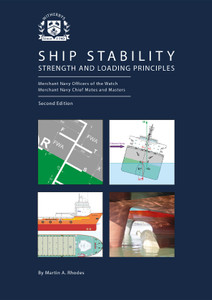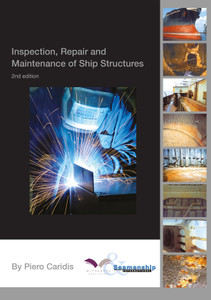
This publication explains the theory and practice of ship manoeuvring and the basics of pilotage. It covers a wide range of manoeuvres and provides practical guidance on the dynamic forces acting on the ship and appropriate use of the ship’s controls. The book is based on the author’s extensive experience as a pilot and is both informative and easy to read.
This book provides those who are training to become pilots, Masters or officers, or other personnel required to manoeuvre ships, with practical ship-handling information on which to build their own strategy for learning and improvement. It provides guidance on the stages and potential risks of each manoeuvre and highlights some of the less obvious features affecting the pilotage of ships.
The second edition reflects the rapid changes in the world of shipping since the publication of the first edition in 2001. The book begins with an ‘Overview of Propulsion, Steering and Bridge Systems’, followed by ‘Basic Principles’, which every reader must understand to be able to manoeuvre a ship, before moving on to more specialised areas such as berthing, towing and anchoring.
There was a time when the essential knowledge pilots needed was the physical nature of their district, including the shape of the channels and depths of water, courses and distances, buoys and other marks, so that they were able to immediately establish the ship’s position at any time and the effect of any tide or current. While they are still expected to have this knowledge and ability, most of this information is now readily available in the form of nautical publications and charts. The ship’s position can easily be obtained by electronic aids, although it still needs to be continuously monitored. Tracking and assessing other ships’ movements and keeping a proper lookout is also necessary.
However, the size of ships has increased significantly in recent decades, with, as an example, ultra large container ships now exceeding 200,000 tonnes and 399 m in length. This means that we are now handling much larger ships, but in the same restricted areas as 50 years ago. However, it is also true to say that, on average, ships handle better now than they used to, that propulsion, navigation and communication systems have improved and that we have better tugs to help us reach the mooring stage. However, the margins have been reduced to a minimum, which means that there is now no room left for error.
Despite the changes, the most important part of the ship handler’s job is still to assess all the elements, risks and dangers and anticipate their effects on the ship. An understanding of local knowledge and customs, being able to anticipate the intentions of other ships and making instant and competent decisions in very restricted areas is important when handling the world’s biggest free moving and most expensive objects and their cargoes.
To handle a ship safely, which is the most important consideration, there is a vital need for anticipation and planning ahead while having a complete idea in your head of what you intend to do, taking into account all the elements.
This book provides those who are training to become pilots, Masters and officers, or anyone else who is likely to be required to manoeuvre ships, with practical ship handling information on which they can build their own strategy for learning and improvement. One of the main purposes of this book is to bring to the forefront some of the less obvious features affecting the pilotage of ships.
Piloting a ship in and out of a port, harbour or waterway can roughly be divided into two separate abilities, both of which improve with experience. Local knowledge is required to safely navigate through the district and technical knowledge is required to manoeuvre a ship at slow speeds (or, in an emergency, at not such slow speeds) in restricted areas, such as when berthing or unberthing, manoeuvring in and out of locks, anchoring and while generally manoeuvring a ship in small spaces.
The technical knowledge can be further divided into the mechanical features, such as the work done by the propeller and rudder, the thrusters and the tugs, which is relatively straightforward, and the physical elements caused by the power of the wind and the tidal stream. The effect of the transverse thrust, which is mechanically generated but cannot be switched off like other mechanical features, must also be taken into consideration. Other effects, such as when using an anchor to assist in the manoeuvring of a ship, can frequently catch out the unwary.
When manoeuvring a ship in small spaces, you will need to watch how the ship responds to the movements you make, make the necessary judgments for action and then correct as necessary. This works up to a point, but requires intuitive judgment and the ability to develop a good feel for a ship. There is nothing mystical about a feel for a ship, it simply means that with experience you are able to assess the way a ship will react to the wind, tide and any other forces acting on it.
When manoeuvring a ship and everything goes according to plan, like any job, it looks easy. However, it is what you do when things go wrong that separates out the competent ship handler. To be a competent ship handler, you need to know how and why various forces and other elements cause ships to react as they do. Furthermore, you need to know how to respond to those reactions as the circumstances and navigational situation evolve.
It is strongly recommended that all ship handlers regularly practise manoeuvring their ship in order to fully understand the handling characteristics. While it may not always be possible to do so in some ports, the Master should ensure that the chief officer as well as second officers gain experience in basic ship handling. In most cases, anchoring provides a good first opportunity for such training. By ensuring that ship handling is regularly practised, it can also be used as a double check against the expected results in the ship’s official manoeuvring data.
Thoughts on pilotage
For pilots, if the Master is manoeuvring the ship, or has even instructed someone other than the pilot to manoeuvre the ship, then the pilot is still required to give their advice. Only if the Master specifically discharges the pilot from their obligations to give advice on the safe conduct of the ship are they released from their duties. If you are not in charge of manoeuvring the ship, try not to feel aggrieved; if you do, and it is possible, walk away and remain calm, but whatever happens never allow it to distract you from making sure the ship is not in any danger. Should you feel that the ship is being put into danger, do not hesitate to intervene.
If you feel there is any ambiguity regarding who is in charge of manoeuvring the ship, it is always a sensible idea to get a specifically agreed understanding from the Master. If you are not sure, ask the Master whether they have taken over; if they suggest a joint operation, beware! I would suggest that either the Master does the ship handling and you advise, or vice versa. You must make it clear to them that you can only accept an arrangement where you are not in charge. The Master must understand that they are ultimately responsible.
If you think, for instance, that there are unique forces to contend with in the manoeuvre, you must bring them to the Master’s attention if you have not already done so.
You may already have many years’ experience at sea and are familiar with various different cultures and religions. This experience will be invaluable to you as a pilot, as you will meet and have to work with all the different nationalities you will find on ships. From time to time, you will have to call on all your tolerance and patience to keep on top of a situation, but believe me, this is much better than showing any loss of control. Nevertheless, it may be necessary, on occasions, to raise your voice to emphasise a point you wish to make.
1.1.2 Medium/high speed diesel engines
1.1.3 Steam boiler and turbine
1.1.4 Dual fuel diesel electric
1.1.5 Other systems
1.2.2 Autopilot
1.2.3 Emergency steering
1.4.2 Variable (controllable) pitch
1.4.3 Ducted propeller (Kort nozzle)
1.5.2 Azimuth thruster
1.5.3 Dynamic positioning (DP)
1.5.4 Jet thruster
1.6.2 Integrated navigation systems
1.6.3 Power supply
1.6.4 Alarm systems
2.3.2 Rate of turn (RoT)
2.4.2 Slowing down with a controllable pitch propeller
2.4.3 Slowing down with azimuth propulsion.
2.4.4 Rudder cycling
2.4.5 Astern movements
2.8.2 Williamson turn
2.8.3 Scharnow turn
2.10.2 Two fixed pitch propellers (rotating inwards)
2.10.3 Two variable pitch propellers (rotating outwards)
2.10.4 Two variable pitch propellers (rotating inwards)
2.11.2 Stopping with variable pitch propeller(s)
2.11.3 Emergency stopping distance (crash stop)
2.11.4 Method of smallest advance
3.1.2 Drifting heading
3.1.3 Wind force moment
3.1.4 Set and drift
3.1.5 River wind phenomenon
3.1.6 Wind effect on turning
3.2.2 Currents
3.3.2 Translational ship motion
3.3.3 Responding to forces
4.3.2 Overtaking
6.4.2 Hydrographic axis
6.4.3 Dynamic axis
7.2.2 Shipping seas
7.2.3 Propeller racing/overspeeding
7.2.4 Torque-rich engine
7.3.2 Reduction in stability
7.3.3 Parametric rolling
7.5.2 Seas from astern
7.5.3 Seas on the beam
8.1.2 Tractor (Voith Schneider)
8.1.3 Azimuth stern drive (ASD)
8.2.2 Berthing
8.2.3 Unberthing
8.3.2 Capsizing (girting)
9.1.2 With tugs
9.1.3 With thrusters
9.1.4 Against the current
9.1.5 With the current
9.2.2 With tugs
9.2.3 With thrusters
9.2.4 Against the current
9.2.5 With the current
9.3.2 Sensors and pilot support systems
10.2.2 Walking out the anchor
10.2.3 Heaving anchor
10.3.2 Standing moor
10.3.3 Running moor
10.4.2 Berthing stern first
10.4.3 Mediterranean moor
10.4.4 Baltic moor
10.4.5 Precautions when using an anchor to berth
11.6.2 Towing alongside
11.6.3 Pushing ahead
11.6.4 Double towing
11.6.5 Tandem or in-line towing
Witherbys
Witherbys titles are developed using scripts developed by technical experts that are peer reviewed within work groups. Typically, they seek to improve understanding of the regulations, recommendations and guidelines issued by Industry.
Witherbys staff have significant expertise in the fields of navigation and hazardous cargoes as well as in the presentation of complex subjects in a graphic and easy to understand manner.
- Number of Pages:
- 197
- Published Date:
- May 2023
- Book Height:
- 210 mm
- Book Width:
- 150 mm
- Author:
Witherbys
- ISBN:
- 9781914993169
- Weight:
- 1.1 kg
- Preview:
- Yes
- Publication Date:
- May 2023






